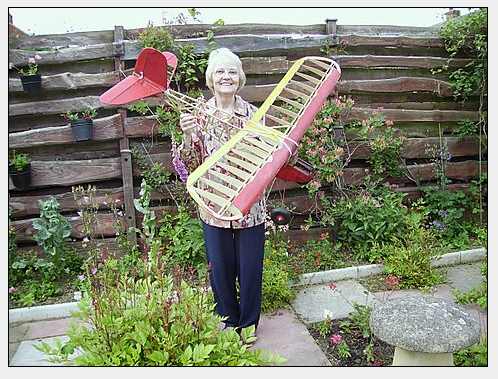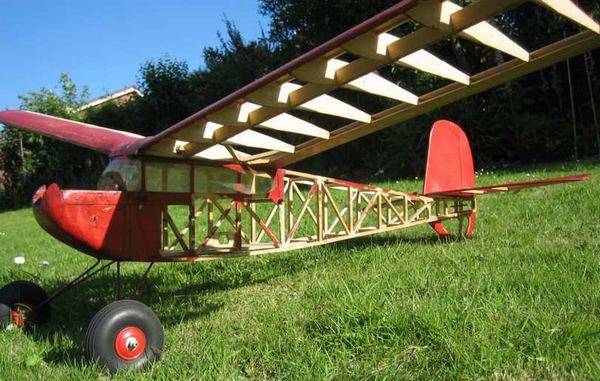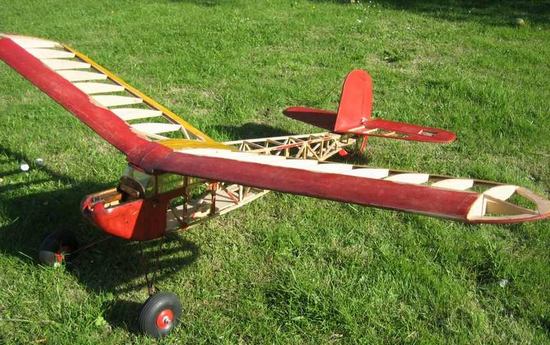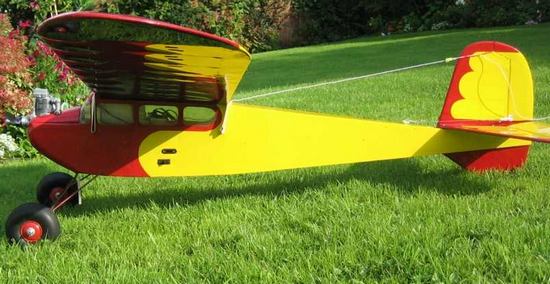
Junior 60
(Model No. 60)
I was given this model by my friend Eddie Ducker who originally bought it in 1953. He built and flew it, free-flight, from then until the mid-1960's when he began converting it for "Radio Assist," but the conversion was never completed. Instead the model was consigned to his loft, where it stayed until May 2008 when I mentioned that I planned to build an "old-timer" to take me back to the early days of my own model-building and flying. Eddie immediately offered me his old J60 - and I just as immediately gratefully accepted it:
Mary, Eddie's co-pilot, displaying the model as it looked at the time it was given to me:

The model seen at closer quarters:


and here after its refurbishment:


Having received the model I spent many hours removing all the debris left-over from the original doped-on tissue. A new SC .30 4-stroke engine was purchased and fitted, along with radio gear comprising GWS (full range) Receiver, GWS Park Servos for the control surfaces, and a Supertec NARO Servo for throttle control. A normal-size 4-cell Rx Battery lives below the engine (after "hollowing-out" the side-checks a little to accommodate it) and the rudder servo lives just ahead of the tail-plane, operating a closed-loop system. The elevator servo is towards the rear and low-down in the cabin using a snake-type push-rod and the throttle servo is just behind the firewall using a wire push-rod attached to the carb's throttle arm. The covering and trim is Solarfilm
The "old - but new in box" wheels seen in the pix were also given to my by Eddie. The tires are pneumatic and have the "Model Shop" logo moulded into the hubs. They also carry the (now rare) "Made In England" mark too
This conversion of an old free flight model to radio control, started by Eddie in the 1960's and completed by me in Aug 2008, had taken more than 40 years to come to completion . . . . but was it worth the wait?
The Maiden Flight
Eddie had accepted my invitation to conduct the "maiden flight under RC" and on Friday 29th August 2008 (55 years after he'd originally bought the model), she took to the air once more. The "maiden" flight was a complete success and the model showed much promise of lots of very leisurely flying to come in the future. Eddie thoroughly enjoyed flying the model. He also enjoyed seeing it fly again several times during the rest of the afternoon under my own control - I love the way it flies
Back in the workshop I later fitted longer wing-band dowels in the interests of "wing-band security" - one wing-band had detached itself during a range-test with the engine running. The band first popped-off and flew into the prop, stopping the engine and then it was deflected rearwards, hitting the neck of another modeller who was attending to his own model! I also added a few more degrees of down-thrust to the engine and am now looking forward to the next test-flight
I decided to try some drastic, super-tight manoeuvres to slow it down, and then "get it down" before the speed could build-up again. I looped and tight-turned it over and over again, getting closer and closer to the ground, and then, just as I was thinking, "I'm never going to pull this off" - the engine cut!